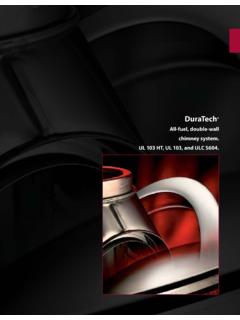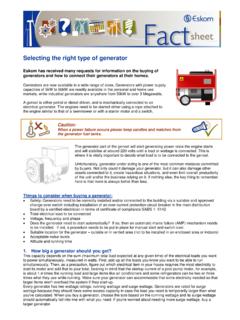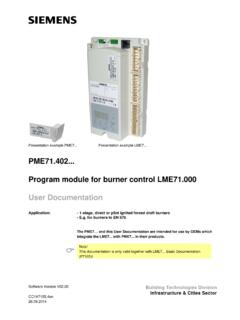Transcription of Energy Performance Certificate
1 XxxxThis home 's Performance is rated in terms of the Energy use per square metre of floor area, energyefficiency based on fuel costs and environmental impact based on carbon dioxide (CO2) on standardised assumptions about occupancy, heating patterns and geographical location, theabove table provides an indication of how much it will cost to provide lighting, heating and hot water to thishome. The fuel costs only take into account the cost of fuel and not any associated service, maintenance orsafety inspection. This Certificate has been provided for comparative purposes only and enables one hometo be compared with another. Always check the date the Certificate was issued, because fuel prices canincrease over time and Energy saving recommendations will see how this home can achieve its potential rating please see the recommended measures.
2 Estimated Energy use, carbon dioxide (CO2) emissions and fuel costs of this homePage 1 of 8 For Training Purposes OnlySample type:Date of assessment:Date of Certificate :Reference number:Total floor area:Mid-terrace house09 June 200731 August 20072903-0016-0000-0051-0006109 m2 The Energy efficiency rating is a measure of theoverall efficiency of a home . The higher the ratingthe more Energy efficient the home is and the lowerthe fuel bills will environmental impact rating is a measure of ahome's impact on the environment in terms ofcarbon dioxide (CO2) emissions. The higher therating the less impact it has on the use302 kWh/m2 per year212 kWh/m2 per yearCarbon dioxide tonnes per tonnes per yearLighting 85 per year 44 per yearHeating 516 per year 414 per yearHot water 162 per year 93 per yearRemember to look for the Energy saving recommended logo when buying Energy efficientproduct.
3 It's a quick and easy way to identify the most Energy efficient products on the advice on how to take action and to find out about offers available to help make your homemore Energy efficient call 0800 12 012 or visit Performance CertificateFor Training Purposes OnlyEnergy Efficiency RatingEnvironmental Impact RatingCurrentPotential Very Energy efficient - lower running costs Not Energy efficient - higher running costsEngland & WalesEU Directive2002/91/ECCurrentPotential Very environmentally friendly - lower C02 emissions Not environmentally friendly - higher C02 emissionsEngland & WalesEU Directive2002/91/EC59715266(92-100)(81-9 1)(69-80)(55-68)(39-54)(21-38)(1-20)(92- 100)(81-91)(69-80)(55-68)(39-54)(21-38)( 1-20)ABCDEFGABCDEFGThe Energy Performance Certificate for this dwelling was produced following an Energy assessmentundertaken by a qualified assessor, accredited by Elmhurst, to a scheme authorised by the Certificate was produced using the RdSAP 2005 assessment methodology and has been producedunder the Energy Performance of Buildings (Certificates and Inspections)(England and Wales) Regulations2007.
4 A copy of the Certificate has been lodged on a national of the assessor and the relevant accreditation scheme are on the Certificate . You can get contactdetails of the accreditation scheme from our website ?? together with details of their procedures forconfirming authenticity of a Certificate and for making a ratings on the Certificate provide a measure of the building's overall Energy efficiency and itsenvironmental impact, calculated in accordance with a national methodology that takes into account factorssuch as insulation, heating and hot water systems, ventilation and fuels used. The average energyefficiency rating for a dwelling in England and Wales is band E (rating 46).Not all buildings are used in the same way, so Energy ratings use 'standard occupancy' assumptions whichmay be different from the specific way you use your building.
5 Different methods of calculation are used forhomes and for other buildings. Details can be found at that are more Energy efficient use less Energy , save money and help protect the environment. Abuilding with a rating of 100 would cost almost nothing to heat and light and would cause almost no carbonemissions. The potential ratings in the Certificate describe how close this building could get to 100 if all thecost effective recommended improvements were of the biggest contributors to global warming is carbon dioxide. The way we use Energy in buildingscauses emissions of carbon. The Energy we use for heating, lighting and power in homes produces over aquarter of the UK's carbon dioxide emissions and other buildings produce a further average household causes about 6 tonnes of carbon dioxide every year.
6 Adopting therecommendations in this report can reduce emissions and protect the environment. You could reduceemissions even more by switching to renewable Energy sources. In addition there are many simple everyday measures that will save money, improve comfort and reduce the impact on the environment, such as: About this document If you have a complaint or wish to confirm that the Certificate is genuine About the building's Performance ratings About the impact of buildings on the environmentVisit the Government's website at to:Page 2 of 8 For Training Purposes OnlyAssessor's accreditation number:Assessor's name:Company name/trading name: number:Fax number:E-mail address:Related party disclosure:.??????lCheck that your heating system thermostat is not set too high (in a home , 21oC in the living room issuggested) and use the timer to ensure you only heat the building when sure your hot water is not too hot - a cylinder thermostat need not normally be higher than 60oClTurn off lights when not needed and do not leave appliances on standby.
7 Remember not to leave chargers( for mobile phones) turned on when you are not using Performance CertificateFor Training Purposes OnlySample EPC, , ., ., .31 August 2007 RRN: 2903-0016-0000-0051-0006lFind how to confirm the authenticity of an Energy Performance how to make a complaint about a Certificate or the assessor who produced more about the national register where this Certificate has been more about Energy efficiency and reducing Energy following is an assessment of the key individual elements that have an impact on this home 'sperformance rating. Each element is assessed against the following scale: Very poor /Poor / Average /Good / Very good. Summary of this home 's Energy Performance related featuresPage 3 of 8 For Training Purposes OnlySample of Certificate :Reference number.
8 31 August 20072903-0016-0000-0051-0006 ElementsDescriptionCurrent performanceWallsCavity wall, as built, no insulation (assumed)PoorPoorRoofPitched, no insulation (assumed)Roof room(s), limited insulation (assumed)Very poorAverageVery poorAverageFloorSolid, no insulation (assumed)--WindowsFully double glazedAverageAverageMain heatingBoiler and radiators, mains gasGoodGoodMain heating controlsProgrammer and room thermostatPoorPoorSecondary heatingRoom heaters, mains gas--Hot waterFrom main system, no cylinderstatAverageAverageLightingLow Energy lighting in 8% of fixed outletsVery poorVery poorCurrent Energy efficiency ratingCurrent environmental impact (CO2) ratingRecommended measures to improve this home 's Energy performanceFor Training Purposes OnlyD 59E 52 Energy EfficiencyEnvironmentalThe measures below are cost effective.
9 The Performance ratings after improvement listed below arecumulative, that is they assume the improvements have been installed in the order that they appear in further measures listed below should be considered in addition to those already specified if aiming forthe highest possible standards for this to the Energy efficiency and environmental impact ratings will usually be in step with eachother. However, they can sometimes diverge because reduced Energy costs are not always accompaniedby a reduction in carbon dioxide (CO2) emissions. Recommendations Further measures to achieve even higher standardsPage 4 of 8 For Training Purposes OnlyLower cost measures(up to 500)Typical savingsper yearPerformance ratings after improvement1 Cavity wall insulation 36D 61D 552 Increase hot water cylinder insulation to 160 mm 17D 62D 563 Low Energy lighting for all fixed outlets 33D 64D 57 Sub-total 86 Higher cost measures(over 500)4 Hot water cylinder thermostat 47D 67D 605 Upgrade heating controls 25D 68D 626 Replace boiler with Band A condensing boiler 54C 71D 66 Total 212 Potential Energy efficiency ratingC 71 Potential environmental impact (CO2) ratingD 667 Solar photovoltaics panels, 25% of roof area 25C 73C 69 Enhanced Energy efficiency ratingC 73 Enhanced environmental impact (CO2)
10 RatingC 69 Energy Performance CertificateFor Training Purposes OnlySample EPC, , ., ., .31 August 2007 RRN: 2903-0016-0000-0051-0006 Energy efficiencyEnvironmentalThese measures are relatively inexpensive to install and are worth tackling first. Some of them may beinstalled as DIY projects. DIY is not always straightforward, and sometimes there are health and safetyrisks, so take advice before carrying out DIY wall insulation, to fill the gap between the inner and outer layers of external walls with an insulatingmaterial, reduces heat loss. The insulation material is pumped into the gap through small holes that aredrilled into the outer walls, and the holes are made good afterwards. As specialist machinery is used to fillthe cavity, a professional installation company should carry out this work, and they should carry out athorough survey before commencing work to be sure that this type of insulation is right for this home .







